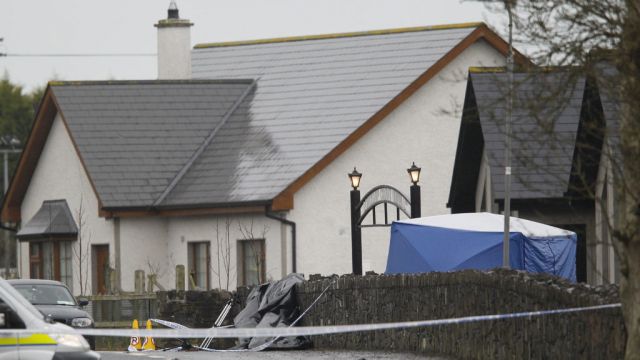The Special Criminal Court has admitted into evidence a back tattoo featuring images that are alleged to be "almost a glorification" and a "pictorial admission" of involvement in the robbery that resulted in the shooting dead of Detective Garda Adrian Donohoe.
Brendan Treanor's lawyers had argued that the tattoo, featuring images of guns, bullets, gangsters, money, knuckle dusters and a car similar to one that is alleged to have been used in the robbery, was irrelevant and should not form part of the prosecution case.
On Wednesday, Mr Justice Tony Hunt ruled the court will consider the tattoo as part of the overall evidence in the case, saying it would be a failure of logic, reason and common sense to disallow it.
Brendan Treanor (34), previously of Emer Terrace, Castletown Road, Dundalk, Co Louth, and James Flynn (32), from South Armagh, are charged with the robbery of €7,000 at Lordship Credit Union in Bellurgan, Co Louth, on January 25th, 2013.
Both men are also charged that between September 11th, 2012, and January 23rd, 2013, they conspired with convicted garda-killer Aaron Brady and others to enter residential premises with the intention of stealing car keys.
The prosecution alleges that Mr Treanor and Mr Flynn were part of a group of young men who conspired to break into houses to steal car keys and then quietly make off with the cars. They have pleaded not guilty to each charge.
Brady (31), previously of New Road, Crossmaglen, Co Armagh, is serving a life sentence with a 40-year minimum having been found guilty of murdering Det Gda Adrian Donohoe and of the robbery at Lordship. Brady denied any involvement in the robbery and is awaiting an appeal against his conviction.
Tattoo
On Wednesday, David Davies told Michael Lynn SC, for Brendan Treanor, that he runs a tattoo parlour in Newtownabbey in North Antrim.
In 2018, Mr Treanor came to his studio looking for a tattoo to cover-up an existing tattoo of a woman's name, possibly an ex-girlfriend, on his back.
The new tattoo had a "gangster theme", the witness said, something that has become trendy in recent years. He added: "People don't have original ideas, it's just: This looks good, I want something like that. It blew up a few years ago, and it's still going. We would have images like that all the time."
He said the images are often from the 50s and 60s or the "old school mob" era, with figures like Al Capone or guns, roles of money, or cars and clothes from that period. Mr Davies said he did not draw Mr Treanor's tattoo but was involved in the design process.
He said the car in the image, a BMW X5 with the registration plate 'Boss BFT', was based on Mr Treanor's own car which was parked facing the window of the shop. A knuckle duster in the image, he said, is a common piece of body art.
Mr Davies pointed to a tattoo on his own face of a knuckle duster. He said it does not suggest an "anti-social" message, and added: "I'm not that person. I'm not a violent person."
He said much of the imagery on Mr Treanor's back, including banknotes, bullets, a long firearm, a handgun and a woman wearing a balaclava while blowing smoke from the barrel of a gun, would be sourced from the internet. "It all ties in to the gangster imagery, the theme. I'm tattooing these on all types of people," he said.
Mr Davies agreed with prosecution counsel Brendan Grehan SC that Mr Treanor would have suggested images that he wanted, including that he wanted his own car rather than an image taken from the internet. He agreed that to the left of the tattoo there appeared to be four gangsters wearing trilby or fedora hats.
The one in the middle, he agreed, was holding a long barrel gun pointing over the roof of the BMW.
It's cool, it's a trend, it's not really a lifestyle
Mr Davies said the image of the woman wearing the balaclava and blowing smoke from the gun is a common type of image on Pinterest. "It's cool, it's a trend, it's not really a lifestyle," he said.
During legal argument, Mr Grehan told the court that the prosecution relies on the tattoo as a piece of circumstantial evidence. He said the tattoo was "almost a glorification" of what happened at Lordship and pointed to five elements that, he said, a jury could consider as amounting to a "pictorial admission" that Mr Treanor was involved in the Lordship robbery.
The evidence, he said, suggested four raiders entered the credit union car park, one armed with a long-armed firearm which was fired across a car, fatally injuring Det Gda Adrian Donohoe.
The driver of the getaway vehicle was alleged by one witness to have been a woman. There was also evidence that the raiders had a handgun and they left with a large sum of cash.
One of the cars that allegedly "played a critical role" before and after the robbery was a BMW 5-Series, counsel said, similar to the car that forms the "centrepiece" of the tattoo.
Mr Grehan said in those circumstances, the tattoo is "an item of circumstantial evidence which a jury are entitled to take into account in assessing the overall prosecution case".
He said it is "a very curious matter" that in 2018, Mr Treanor decided to have that image tattooed on his back when in 2013 he had gone to a police station in Northern Ireland to make a statement because of suspicions circulating that he had been involved in the Lordship robbery.

He said the fact Mr Treanor went "perhaps when he thought this was all behind him" to get this particular tattoo is a matter for a jury, in this case the three judges of the Special Criminal Court, to consider.
Mr Lynn told the court the tattoo should not be admitted into evidence as it was irrelevant and has "no probative value going to any possible finding of guilt". It was, he said, a "cover-up tattoo" featuring common imagery with "nothing unusual".
Mr Justice Hunt said it was an odd way to cover up the tattoo, given the background of the case.
In the court's ruling, Mr Justice Hunt said it would be a failure of logic, reason and good sense for a jury not to be allowed to consider the tattoo as evidence. He said it "comfortably passes any threshold" for consideration in the trial.







